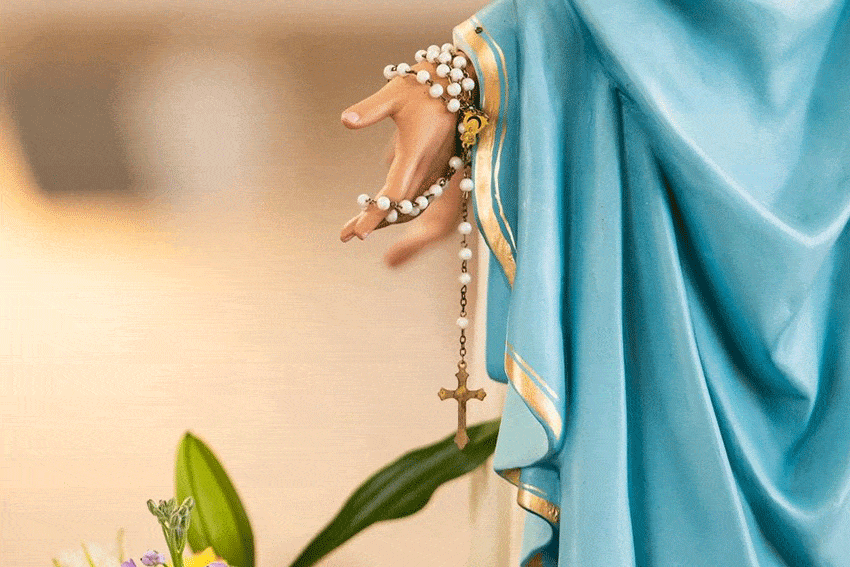
By Father Eli Yammine
The Rosary is perhaps one of the most important prayer tools used by Catholics.
When people see someone with a Rosary they immediately think Catholic! However, as Catholics we do not always use the Rosary for prayer – it has become more symbolic and is nowadays often used as an accessory in homes and in cars, worn as a necklace or on the wrist, even applied as a tattoo.
To realise the significance of the Rosary, it is important to understand its origin and evolution.
In the Eastern Churches, the Rosary was not a part of our spiritual tradition in the past.
However the Rosary as we Maronites and Eastern Catholics know it today came through Latin missionaries after the 16th Century and it became popular around the late 18th Century.
Prior to that we had our own traditional prayer “rope”, which consisted of knotted strings; 150 knots on a string to be exact. And it was never used as a Marian prayer.
“You have the fringe so that, when you see it, you will remember all the commandments of the Lord …”
As an Eastern Church, most of our religious accessories, vessels and clothing have their origin in biblical sources especially from the Torah and Jewish tradition. In the book of Numbers we read, “The Lord said to Moses, speak to the Israelites and say to them: ‘Throughout the generations to come you are to make tassels on the corners of your garments, with a blue cord on each tassel.” (Numbers 15:37-38)
And again in Deuteronomy we read, “You shall make yourself tassels on the four corners of your garment with which you cover yourself.” (Deuteronomy 22:12)
The tassels here refer to twisted or knotted strings of wool that are called Tzitzit and the garment that is the Tallit. Every Tallit has four Tzitzits attached to it, worn either under or over clothing.
The purpose of the Tzitzit is revealed by our Lord God in Numbers 15 : 39: “You have the fringe so that, when you see it, you will remember all the commandments of the Lord and do them and not follow the lust of your own heart and your own eyes.”
Some Jewish tradition suggests that ancient Jews touched the knots on the Tzitzit attached to their tallit at specific points in their prayers.
In the New Testament we find an interesting account in Luke 8: 44 when the Haemorrhaging Woman “… came up behind him [Jesus] and touched the fringe of his garment, and immediately her flow of blood stopped.”

How beautiful is the notion that the Hemorrhaging Woman, filled with faith, who would have touched the tassels worn by our Lord as a form of prayer.
Now while early Christians continued praying like their forebears – reciting and contemplating the 150 Psalms as part of the daily prayer devotion – more and more Gentiles started coming to the Lord.
And since the Goyim (non-Jews) had neither Tallits nor Tzitzits, the practice of using beads or stones began, counting out 150 small stones from a sack to track the number of psalms prayed.
These were used for counting to aid in prayer and not for repetition. Let us remember that our Lord criticised repetition prayers, as he said in Matthew 6:7 “And when you pray, do not heap up empty phrases as the Gentiles do, for they think that they will be heard for their many words.”
Our ancestors understood that every phrase uttered in prayer has a meaning and that it becomes empty when repeated without thinking or meditation on what we say or read.
Our Eastern tradition teaches that the Church Fathers and the hermits of the 3rd and 4th centuries, especially Antonios the Great and Pachomius the Great, used knotted ropes to count prayers, typically for praying the 150 Psalms of David and later, meditating on a prayer which they invented (“Lord Jesus Christ, Son of God, have mercy on me, a sinner”).
“Subsequently, the practice started to spread among lay people, especially around the 7th Century, to count 150 of the Lord’s Prayer if they didn’t know how to read the psalms, given that scriptures at the time were in Latin.”
In the Vita of Saint Paul of Thebes (227-342 AD) written by Saint Jerome, we read that Saint Paul of Thebes used pebbles and knotted cord to count prayers.
So the mystics over time also started using strings with knots for prayer, which eventually evolved in the Western Church into using strings with pieces of wood, small sea shells or salmon fish back bones.
Subsequently, the practice started to spread among lay people, especially around the 7th Century, to count 150 of the Lord’s Prayer if they didn’t know how to read the psalms, given that scriptures at the time were in Latin.
The Catholic Encyclopedia mentions strings of beads for prayer, found in the tomb of Saint Gertrude of Nivelles (7th Century).
The structure of the Rosary gradually evolved closer to how we know it today, between the 12th and 15th centuries.
But the question now is; how did the meaning and tradition of the Rosary in Eastern Churches and more specifically, the Maronite Church come about? Stay tuned for part II in next week’s edition.
Father Eli Yammine is Assistant Priest at Saint Joseph’s Maronite Catholic Church in Croydon, NSW.
